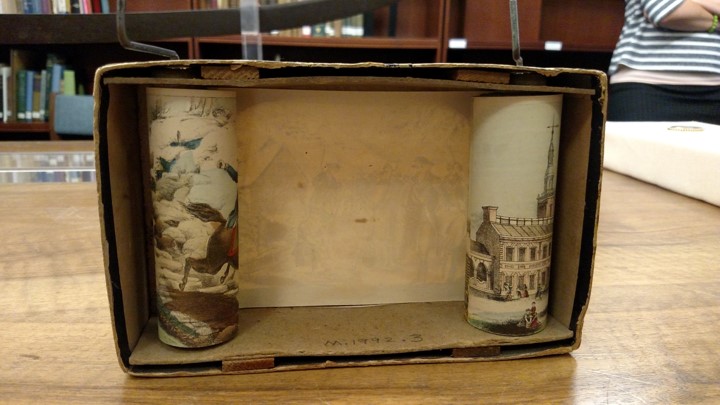Rikki Davenport, Charleston County School District, Mount Pleasant, South Carolina
DESIGN LEVEL: Middle School-High School
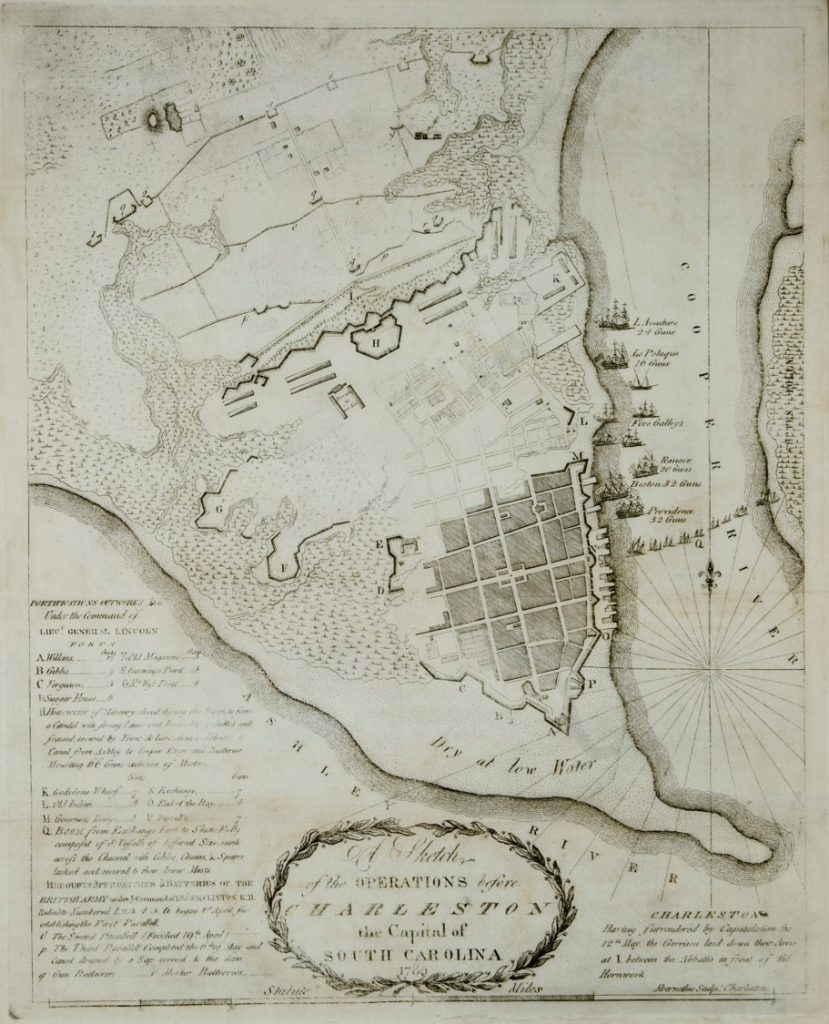
Overview
The events surrounding the American Revolution transformed British colonists into American citizens. This lesson will help students understand South Carolina’s pivotal role in this process.
Objectives
Students will demonstrate an understanding of the causes of the American Revolution and the beginnings of the new nation, with an emphasis on South Carolina’s role in the development of that nation. Students will summarize the role of South Carolinians in the course of the American Revolution, including the use of partisan warfare, the battles of Camden, Cowpens, Kings Mountain and Eutaw Springs, and the experience of the city of Charleston, addressing the following Essential Questions:
- What event in the war led to the British decision to invade Charleston?
- What were the British hoping to achieve by launching a campaign in the South?
- How did the siege impact common people in Charleston?
- Why did the Patriots surrender Charleston?
- What effect did this surrender have on General Washington and the Patriot war effort?
- How did what happened during the Charleston surrender play into the British surrender at Yorktown, Virginia?
- How did the Siege of Charleston contribute to the eventual Patriot victory?
Materials
- A Gallant Defense: the Siege of Charleston, 1780 / Borick, Carl P., 1966-. Columbia University of South Carolina, c2003. (optional for background history)
- Abernethie. Sketch of the Operations before Charleston the Capital of South Carolina, 1780. Charleston [or Trenton]: s.n. [Isaac Collins?, 1785]. The Society of the Cincinnati, The Robert Charles Lawrence Ferguson Collection.
- Edinburgh Evening Courant, extraordinary edition, 9 July 1780. Edinburgh: Printed for Fleming and Ramsay …, 1780. The Society of the Cincinnati, The Robert Charles Lawrence Ferguson Collection.
- Ms. Davenport’s PowerPoint PDF
- SmartBoard with board “markers” (optional)
- iPads (optional for formal assessment)
- “The Historiscope: A Panorama & History of America.” Milton Bradley & Co., Springfield, Massachusetts, ca. 1860-1890. The Society of the Cincinnati, The Robert Charles Lawrence Fergusson Collection.
- Materials to construct historiscopes: shoe boxes, pencils for cranks, paper rolls, color pencils, glue, tape, etc.
- YouTube videos showing the workings of a historiscope or crankie:
LOOK A Historiscope
The Elk Herd Crankie
Recommended Time
Two 60-minute class periods.
Activity
Day 1:
Bell ringer: Create a mind map using the word siege. Discuss as a class then categorize the words that have relevance in 1780 Charleston.
Introduce content/review prior knowledge:
- On June 28, 1776, the British were rebuffed by a “rag tag” group at Fort Sullivan operating from a partially complete palmetto log fort in Charleston Harbor.
- This victory allowed South Carolina to support the Patriot war effort in the North and dissuaded the British from again attempting to take the city until 1780.
In small groups, have students study the map of the Charleston Harbor dated 1780. (Ms. Davenport puts the maps on her Google Classroom website to save paper and to allow students to zoom in and out on the image to see more detail.)
Tell the students “It’s the spring of 1780 and the British have once again returned to the Lowcountry in an attempt to take Charleston.”
Share Ms. Davenport’s Powerpoint PDF with the class on a SmartBoard, displaying the map of the Charleston peninsula. Divide students into small groups designated as either Patriot or British forces, and ask students to study the map of the Charleston peninsula to decide what plan of attack the British would pursue, and what plan of defense Patriots would pursue. Allow five to ten minutes for students to make their plans. Ask for a volunteer from a British group and a volunteer from a Patriot group to share their plans. They may use SmartBoard pens to mark up the peninsula map on the screen (informal assessment).
Congratulate the groups on their stellar plans then tell the real story:
- In late March 1780, 8,000 British soldiers in West Ashley camped along the Ashley River from Drayton Hall to Middleton Place. From there, they prepared for what they hoped would be the last major battle of the war. (After all, capturing Charleston would in effect capture the wealth and one of the major supply lines of the Patriots, and the British believed that large numbers of Loyalists would join them to fight for the king.)
- British General Henry Clinton led the attack on Charleston. He had failed in the 1776 attack and was determined to get it done right this time!
- On the night of March 28, 1780, British soldiers camped in West Ashley, crossed the river and began an approximately thirteen-mile march towards Charleston.
- While the British soldiers marched, British ships sailed into Charleston Harbor. By the morning of March 29th, the siege had begun. With both land and water blocked by the British, Continental Army General Benjamin Lincoln was cut off from reinforcements, and 5,000 Patriot soldiers and the town’s civilians suffered a six-week siege until forced to surrender on May 12, 1780. Instead of respecting the rank of an officer and allowing a respectable surrender, Lincoln was snubbed by the British who saw him as a traitor to the Crown. The surrender was done without any type of formal ceremony. (Not to worry—Lincoln would prevail later from this slight.)
- The fall of Charleston was the single largest Patriot defeat of the entire American Revolution.
- This battle was so important to the British war effort that news of the event was published in newspapers across the globe (display example of Scottish newspaper). Why would other countries care if the British won a battle in South Carolina? (It could secure more British allies or lose Patriot allies.)
- Instead of Loyalists joining the British forces as they expected, many turned towards the Patriot cause as a result of the British treatment of Patriot soldiers and civilians, which was viewed as brutal. Homes, farms and churches were destroyed, civilian property was confiscated, and people were put in prisons with deplorable conditions until they signed loyalty oaths.
- This event led to the rise of South Carolina’s best known Revolutionary War heroes: Francis Marion, Thomas Sumter and Andrew Pickens.
- The Patriot resolve after the siege strengthened. On October 19, 1781, Patriot troops surrounded Lord Cornwallis’ troops in Yorktown, Virginia, much like the British surrounded Charleston the previous year.
- Lord Cornwallis was forced to surrender but too embarrassed to surrender himself—he sent his second-in-command. Remembering how General Lincoln was slighted during the surrender of Charleston, General Washington insisted that the official surrender be received by General Lincoln. The surrender came full circle, however, the war was not over.
- By December 1781, Patriot troops were within fifteen miles of Charleston, and on December 14, 1782, the last British troops left Charleston (except for a few of the Hessians who wanted to stay and hid in the chimney of the grand downtown houses until the British ships sailed away).
Return to the Essential Questions and have students (working in their small groups) record detailed responses (formal assessment).
Day 2:
Show images of the historiscope from the collection of the Society of the Cincinnati. Explain how history was used as an inspiration for children’s toys. Show a video on how a historiscope (or crankie) works.
In small groups, have students create a historiscope with a script based chronologically upon one of the battles in South Carolina (Camden, King’s Mountain, Cowpens, Eutaw Springs). Students can use iPads to make an iMovie that shows the cranking of their group’s historiscope with narrators reading their script. Show the iMovies on the SmartBoard (formal assessment).
Standards Addressed
COMMON CORE: English Language Arts Standards—History/Social Studies—Grade 6-8
Historical Analysis and Skills Development: Reading, Writing, Speaking, Listening; Writing: Key Ideas and Details; Craft and Structure: Integration of Knowledge and Ideas
2019 SOUTH CAROLINA SOCIAL STUDIES CAREER-AND-COLLEGE READY STANDARDS
Grade 8 South Carolina and the United States
Standard 8-2: Demonstrate an understanding of how South Carolinians and Americans created a revolutionary form of government during the period of 1757– 1815.
Enduring Understanding:
Political and economic developments underscored how the colonists in British North America had become uniquely American, prompting the development of a new nation. Drawing on their experience under British rule, the founding generation created a government with shared powers between the state and federal institutions.
8.2.CO Compare the motives and demographics of loyalists and patriots within South Carolina and the colonies. This indicator was developed to encourage inquiry into the economic, political, and social motivations of the patriots and the loyalists in the era of the American Revolution.
8.2.CE Explain the economic, political, and social factors surrounding the American Revolution. This indicator was developed to encourage inquiry into how the colonies began to unify to create a distinctive American identity over the course of events of the American Revolution.
Grade 4 United States & South Carolina Studies Part I
Themes: Civic Participation, Cultural Interactions, Geographic Relationships, Interactions Among People, Physical Geography and Natural Resources
Deconstructed Skills: Comparison, Causation, Context, Evidence
4.1.E, 4.2.CO, 4.2.CX, 4.2.E
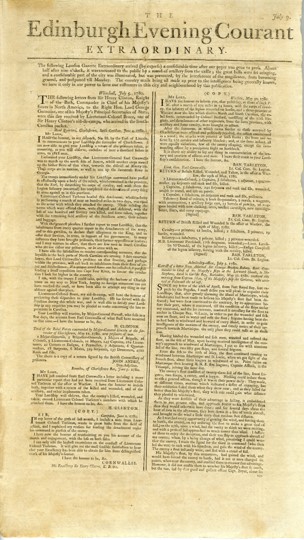
Edinburgh: Printed for Fleming and Ramsay, July 9, 1780
The Society of the Cincinnati, The Robert Charles Lawrence Ferguson Collection
This newspaper announces the fall of Charleston, South Carolina, to British forces and includes Sir Henry Clinton's June 4, 1780, letter from Charleston.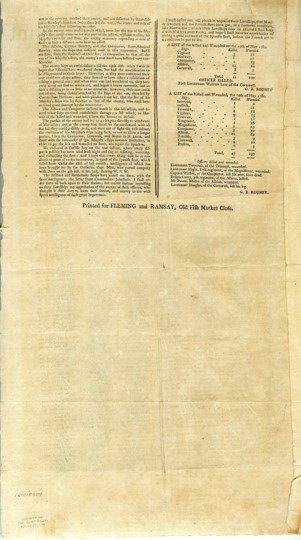
Edinburgh: Printed for Fleming and Ramsay, July 9, 1780
The Society of the Cincinnati, The Robert Charles Lawrence Ferguson Collection
This newspaper announces the fall of Charleston, South Carolina, to British forces and includes Sir Henry Clinton's June 4, 1780, letter from Charleston.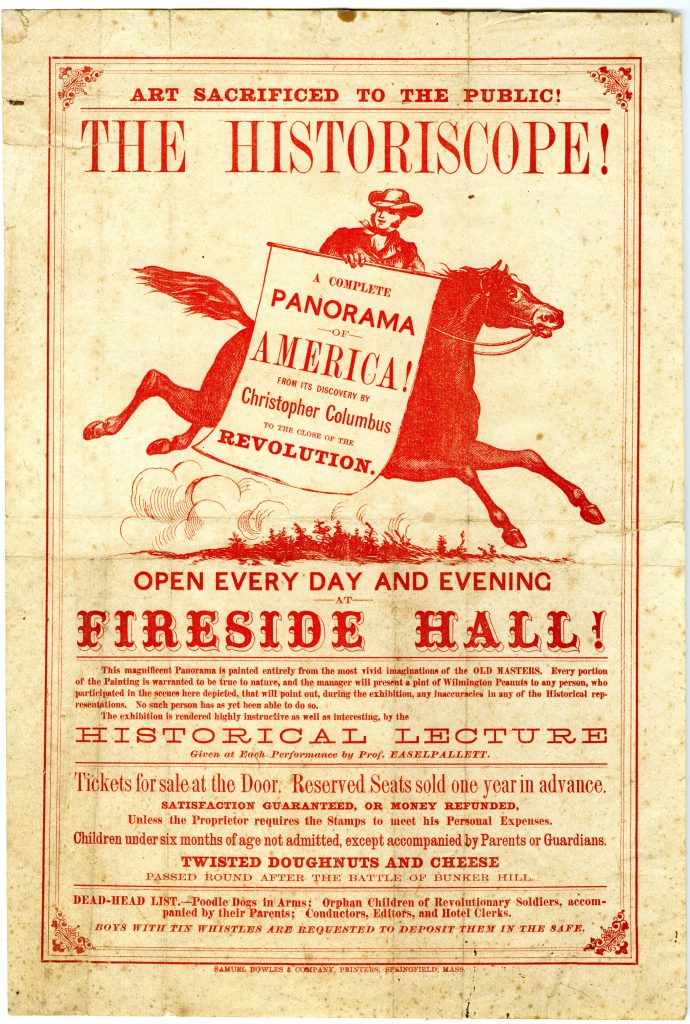
Art Sacrificed to the Public! The Historiscope!
Springfield, Mass.: Samuel Bowles & Co., printers, 1868The Society of the Cincinnati, The Robert Charles Lawrence Fergusson Collection
This satirical broadside accompanied the toy and was intended to advertise "performances." Also included were admission tickets and a script to be read to the audience.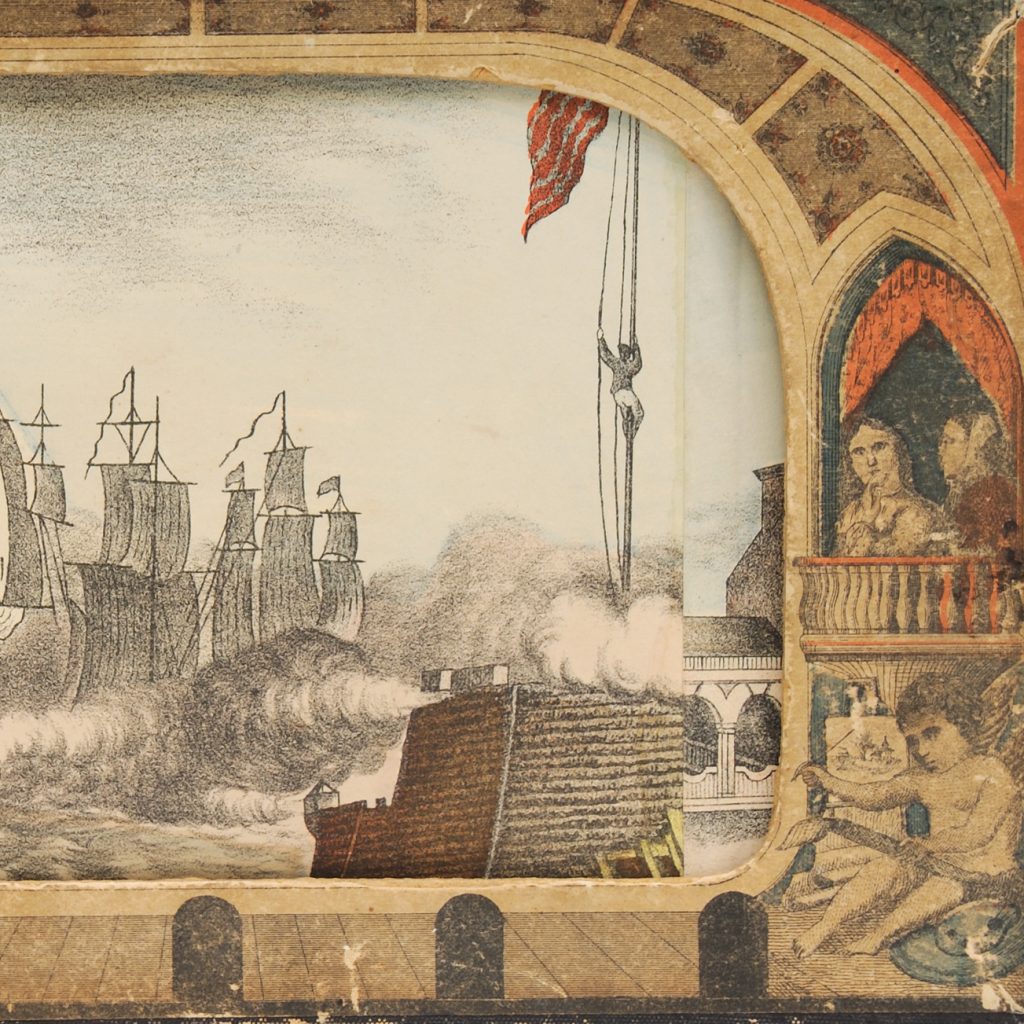
"The Historiscope: A Panorama & History of America" [Fort Moultrie]
Milton Bradley & Co., Springfield, Massachusetts
ca.1860-1890The Society of the Cincinnati, The Robert Charles Lawrence Fergusson Collection
This toy consists of a scrolling set of twenty-four hand-colored lithographs set into a theatrical background. A child would present the images to their family as a show, using a script that accompanied the toy. Half of the scenes depict heroes and events of the Revolutionary War, reflecting what mid-nineteenth century Americans celebrated from the nation's founding. This scene depicts the 1776 British attack on Fort Moultrie in South Carolina.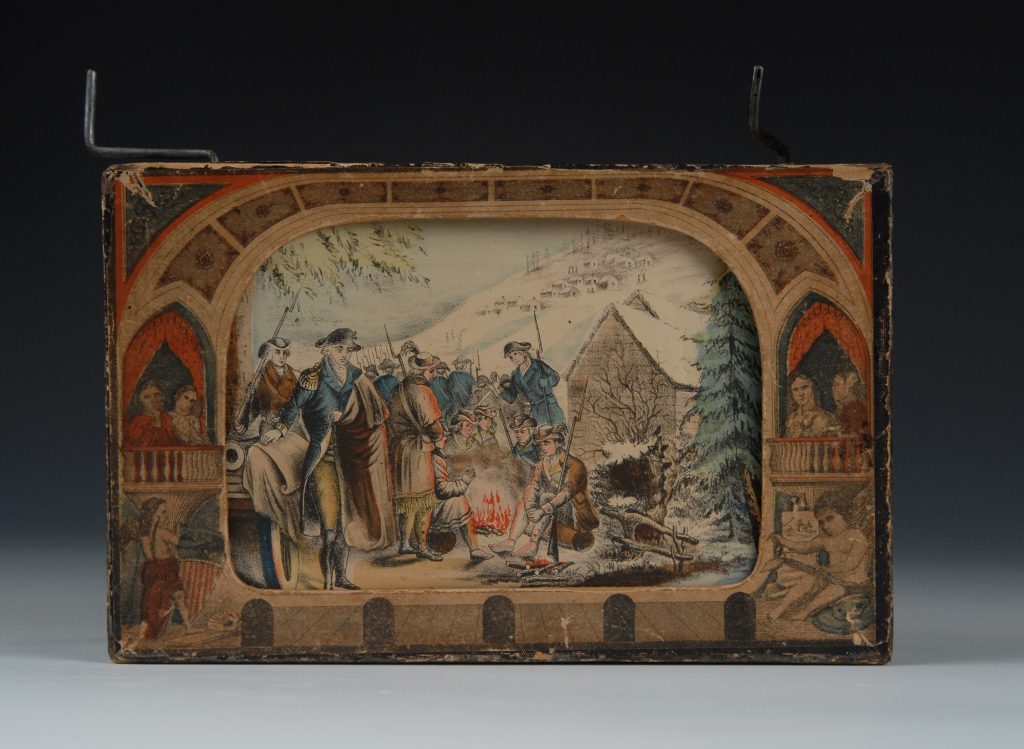
"The Historiscope: A Panorama & History of America" [Valley Forge]
Milton Bradley & Co., Springfield, Massachusetts
ca.1860-1890The Society of the Cincinnati, The Robert Charles Lawrence Fergusson Collection
The accompanying script reads, "In December 1777, Washington took up his Winter quarters at Valley Forge, and with rude huts for shelter, often times destitute of food, without blankets for the night, or sufficient clothing, the Patriot army passed the darkest hours of the Revolution."